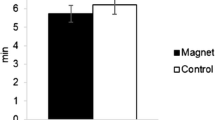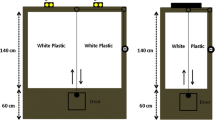Abstract
An experimental group of homing pigeons (Columba livia f. domestica) learned to associate food with a magnetic anomaly produced by bar magnets that were fixed to the bowl in which they received their daily food ration in their home loft; the control group lacked this experience. Both groups were trained to search for two hidden food depots in a rectangular sand-filled arena without obvious visual cues; for the experimental birds, these depots were also marked with three 1.15 × 106 μT bar magnets. During the tests, there were two food depots, one marked with the magnets, the other unmarked; their position within the arena was changed from test to test. The experimental birds searched within 10 cm of the magnetically marked depot in 49% of the test sessions, whereas the control birds searched there in only 11% of the sessions. Both groups searched near the control depot in 11 and 13% of the sessions, respectively. The significant preference of the magnetically marked food depot by the experimental birds shows that homing pigeons cannot only detect a magnetic anomaly but can also use it as a cue for locating hidden food in an open arena.

Similar content being viewed by others
References
Beason RC, Brennon WJ (1986) Natural and induced magnetization in the bobolink (Dolichonyx orycivorus). Ethology 91:75–80
Beason RC, Nichols JE (1984) Magnetic orientation and magnetically sensitive material in a transequatorial migratory bird. Nature 309:151–153
Beason RC, Semm P (1996) Does the avian ophthalmic nerve carry magnetic navigational information? J Exp Biol 199:1241–1244
Beason RC, Wiltschko R, Wiltschko W (1997) Pigeon homing: effects of magnetic pulses on initial orientation. Auk 114:405–415
Bookman MA (1977) Sensitivity of the homing pigeon to an earth-strength magnetic field. Nature 267:340–342
Davila AF, Fleissner G, Winklhofer M, Petersen N (2003) A new model for a magnetoreceptor in homing pigeons based on interacting clusters of superparamagnetic magnetite. Phys Chem Earth 28:647–652
Edmonds DT (1996) A sensitive optically detected magnetic compass for animals. Proc R Soc Lond B 263:295–298
Fleissner G, Holtkamp-Rötzler E, Hanzlik M, Winklhofer M, Fleissner G, Petersen N, Wiltschko W (2003) Ultrastructural analysis of a putative magnetoreceptor in the beak of homing pigeons. J Comp Neurol 458:350–360
Fleissner G, Stahl B, Thalau P, Falkenberg G, Fleissner G (2007) A novel concept of Fe-mineral based magnetoreception: new histological and physiochemical data from the upper beak of homing pigeons. Naturwissenschaften (in press). doi: 10.1007/s00114-007-0236-0
Freire R, Munro UH, Rogers LJ, Wiltschko R, Wiltschko W (2005) Chickens orient using a magnetic compass. Curr Biol 15:R620–R621
Gray E, Spetch ML, Kelly DM, Nguyen A (2004) Searching in the center: pigeons (Columba livia) encode relative distance from walls of an enclosure. J Comp Psychol 118:113–117
Hanzlik M, Heunemann C, Holtkamp-Rötzler E, Winklhofer M, Petersen N, Fleissner G (2001) Superparamagnetic magnetite in the upper beak tissue of homing pigeons. BioMetals 13:325–331
Kirschvink JL, Gould JL (1981) Biogenic magnetite as a basis for magnetic field detection in animals. Biosystems 13:181–201
Kirschvink JL, Walker MM (1986) Biogenic magnetite in higher organisms and the current status of the hypothesis of ferrimagnetic magnetoreception. In: Maret G, Boccara N, Kiepenheuer J (eds) Biophysical effects of steady magnetic fields. Springer, Berlin Heidelberg New York, pp 180–188
Mora C, Davison M, Wild JM, Walker MM (2004) Magnetoreception and its trigeminal mediation in the homing pigeon. Nature 432:508–511
Munro U, Munro JA, Phillips JB, Wiltschko R, Wiltschko W (1997) Evidence for a magnetite-based navigational ‘map’ in birds. Naturwissenschaften 84:26–28
Reille A (1968) Essai de mise en évidence d’une sensibilité du pigeon au champ magnétique à l’aide d’une conditionnement nociceptif. J Physiol (Paris) 60:85–92
Semm P, Beason RC (1990) Responses to small magnetic variations by the trigeminal system of the bobolink. Brain Res Bull 25:740–753
Shcherbakov VP, Winklhofer M (1999) The osmotic magnetometer: a new model for magnetite-based magnetoreceptors in animals. Eur Biophys J 28:380–392
Stahl B, Fleissner G, Falkenberg G, Fleissner G (2006) Magnetite nanoparticles alone are not able to explain iron mineral-based magnetoreception in homing pigeons. In: Kyriakopoulos A, Michalke B Graebert A, Behne D (eds) Proceedings of the 4th Fall Conference on metalloproteins and metalloidproteins. Herbert Utz Verlag, München, pp 63–68
Tommasi L, Vallortigara G (2000) Searching for the center: spatial cognition in the domestic chick (Gallus gallus). J Exp Psychol Anim Behav Processes 26:477–486
Tommasi L, Vallortigara G (2004) Hemispheric processing of landmark and geometric information in male and female domestic chicks (Gallus gallus). Behav Brain Res 155:85–96
Tommasi L, Vallortigara G, Zanforlin M (1997) Young chickens learn to localize the center of a spatial environment. J Comp Physiol A 180:567–572
Williams MN, Wild JM (2001) Trigeminally innervated iron containing structures in the beak of homing pigeons and other birds. Brain Res 889:243–246
Wiltschko R, Wiltschko W (1995) Magnetic orientation in animals. Springer, Berlin Heidelberg New York, 203–215
Wiltschko R, Wiltschko W (1996) Magnetoreception: why is conditioning so seldom successful? Naturwissenschaften 83:241–247
Wiltschko W, Wiltschko R (2005) Magnetic orientation and magnetoreception in birds and other animals. J Comp Physiol A 191:675–693
Winklhofer M, Holtkamp-Rötzler E, Hanzlik M, Fleissner G, Petersen N, (2001) Clusters of superpara-magnetic magnetite particles in the upper-beak skin of homing pigeons: evidence of a magnetoreceptor? Eur J Mineral 13:659–669
Yorke ED (1979) A possible magnetic transducer in birds. J Theor Biol 77:101–105
Acknowledgements
Our work was supported by the Deutsche Forschungsgemeinschaft (grant to W.W.). We thank Jörg Oehlmann for help with the statistical analysis, Helmut Prior and Christiane Wilzeck for their critical comments and four anonymous reviewers for their helpful suggestions. The experiments were performed in accordance with the rules and regulation of animal welfare in Germany.
Author information
Authors and Affiliations
Corresponding author
Rights and permissions
About this article
Cite this article
Thalau, P., Holtkamp-Rötzler, E., Fleissner, G. et al. Homing pigeons (Columba livia f. domestica) can use magnetic cues for locating food. Naturwissenschaften 94, 813–819 (2007). https://doi.org/10.1007/s00114-007-0259-6
Received:
Revised:
Accepted:
Published:
Issue Date:
DOI: https://doi.org/10.1007/s00114-007-0259-6




